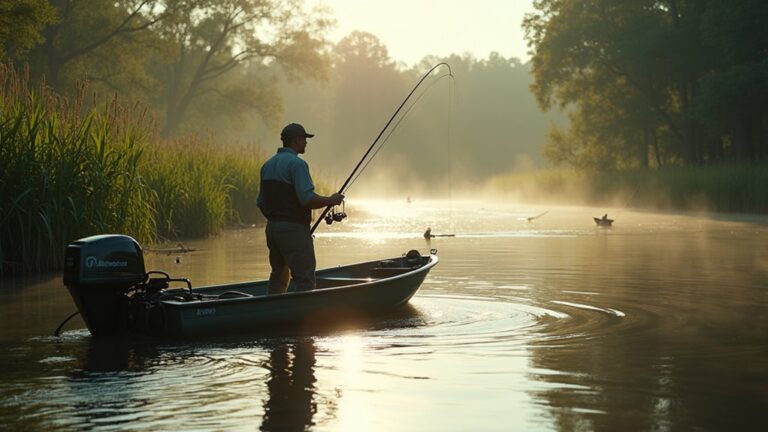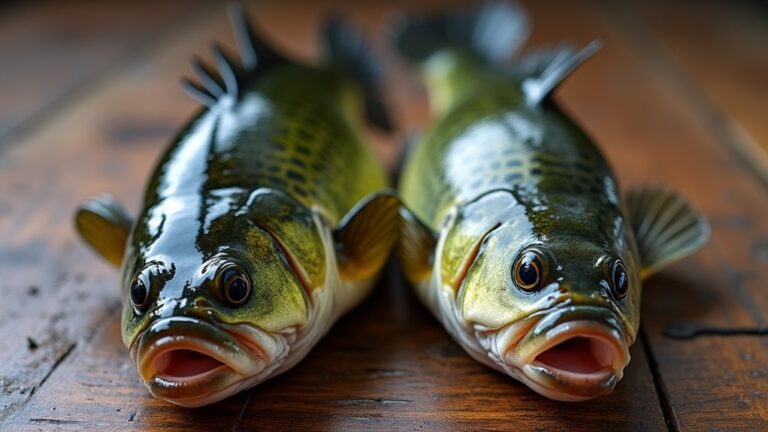To spot common saltwater fish like snapper, grouper, and tuna, focus on key identification features. Look for body shape; snapper are vibrant and streamlined, while groupers are stout with large mouths. Check their coloration too—sharp patterns and colors can signal what you're seeing. Monitor their behavior; for instance, tuna are fast swimmers often found in schools. Pay attention to fins and tail shapes, as these differ among species. By honing in on these traits, you'll boost your identification skills and soon find identifying fish comes easily. Explore further for tips and tricks that can enhance your experience!
Overview of Saltwater Fish Species
Diving into the world of saltwater fish reveals a stunning array of species that inhabit oceans and seas around the globe. Each of these fish plays a significant role in their respective ecosystems, contributing to the balance of marine life.
From vibrant coral reefs to the deep blue sea, you'll find fascinating varieties, each adapted to their unique environments.
When you think about saltwater fish, consider those commonly sought after for sport fishing or culinary purposes. Popular species include snapper, grouper, and tuna, each boasting distinct flavors and textures.
You might also encounter colorful reef fish such as parrotfish and clownfish, known for their striking appearances and lively behaviors.
Understanding the diversity of saltwater fish helps you appreciate their ecological significance. Some species are imperative for maintaining coral health, while others help control algae growth.
As you explore, keep in mind that saltwater fish aren't just beautiful; they're fundamental to sustaining marine biodiversity.
By learning more about these species, you can better appreciate the health of our oceans and the importance of their conservation.
Key Identification Features
Identifying saltwater fish can be both exciting and challenging, as each species has distinct characteristics. To effectively recognize different types, you'll want to pay attention to several key identification features.
First, look at the body shape. Fish can be elongated, flattened, or even oval, which can give you clues about their habitat and behavior.
Next, examine the coloration and patterns. Many fish have unique colorations or markings that can help you distinguish one species from another. For instance, stripes, spots, or even iridescent scales can be considerable indicators.
Don't overlook the fins and tail. The shape and size of dorsal, pectoral, and tail fins vary considerably across species, aiding in identification.
Additionally, the mouth shape can provide insights; some fish have small mouths suited for grazing, while others sport large mouths for predation.
Lastly, consider the size and any distinctive features, such as spines or barbels. Taking note of these key identification features will enhance your ability to spot and identify various saltwater fish, making your fishing experience more rewarding.
Common Saltwater Fish Types
When exploring the diverse world of saltwater fishing, you'll encounter a variety of common fish types that you can expect to catch. One of the most popular is the snapper, known for its vibrant colors and excellent taste. You'll often find red snapper in deeper waters, making them a prized catch for many anglers.
Another common type is the grouper, which can weigh up to several hundred pounds. Their stout bodies and large mouths make them easily identifiable. If you're fishing near reefs, keep an eye out for them.
You might also encounter tuna, a fast-swimming fish that's sought after for both sport and sustenance. Yellowfin and bluefin are the most common species, and their size makes them a thrilling challenge to reel in.
Don't forget about the mahi-mahi, or dolphinfish, known for their striking colors and acrobatic jumps. They're typically found in warmer waters and are a favorite for many anglers.
Lastly, consider the flounder, a flatfish that's often caught near the ocean floor.
With these common saltwater fish types in mind, you'll be well-prepared for your next fishing adventure!
Habitat and Behavior Insights
Saltwater fish thrive in a variety of habitats, each influencing their behavior and feeding patterns. You'll find them in coral reefs, open oceans, estuaries, and along coastal shores. Each environment provides unique resources, shaping how fish interact with their surroundings.
In coral reefs, for instance, fish like clownfish and angelfish exhibit vibrant colors and complex social structures. They often hide among the corals for protection and rely on the reef's biodiversity for food.
In contrast, open ocean fish, such as tuna and mackerel, are built for speed and often travel in schools, allowing them to hunt efficiently and evade predators.
Estuaries serve as nurseries for many species, where juvenile fish find shelter in brackish waters. Here, they develop their skills before moving to more challenging environments.
Coastal areas are rich in nutrients, attracting fish that feed on smaller organisms. You'll notice behaviors like foraging and schooling, which help these fish survive.
Tips for Accurate Identification
Recognizing the diverse habitats and behaviors of saltwater fish can greatly enhance your identification skills. To accurately identify fish, focus on these key aspects: coloration, body shape, and fin structure. Observe the fish in its natural environment, as this can provide context and help you distinguish between similar species.
Here's a quick reference table to guide you:
| Feature | Description | Example Species |
|---|---|---|
| Coloration | Patterns and hues that differ | Clownfish |
| Body Shape | Streamlined, oval, or flat | Flounder |
| Fin Structure | Number and shape of fins | Sailfish |
When examining a fish, pay attention to its size, as it can vary considerably within species. Also, consider the time of year, since seasonal changes can affect fish appearance and behavior. Finally, utilize reliable field guides or apps to confirm your findings. By sharpening your observational skills and referencing key features, you'll become more adept at identifying saltwater fish on your next outing.
Conclusion
To sum up, knowing how to identify common saltwater fish can enhance your fishing experience and boost your success. Did you know that over 30% of the world's fish catch comes from saltwater species? By familiarizing yourself with key features and behaviors of these fish, you'll not only improve your skills but also contribute to sustainable fishing practices. So next time you're out on the water, put your identification skills to the test and enjoy the thrill of the catch!




